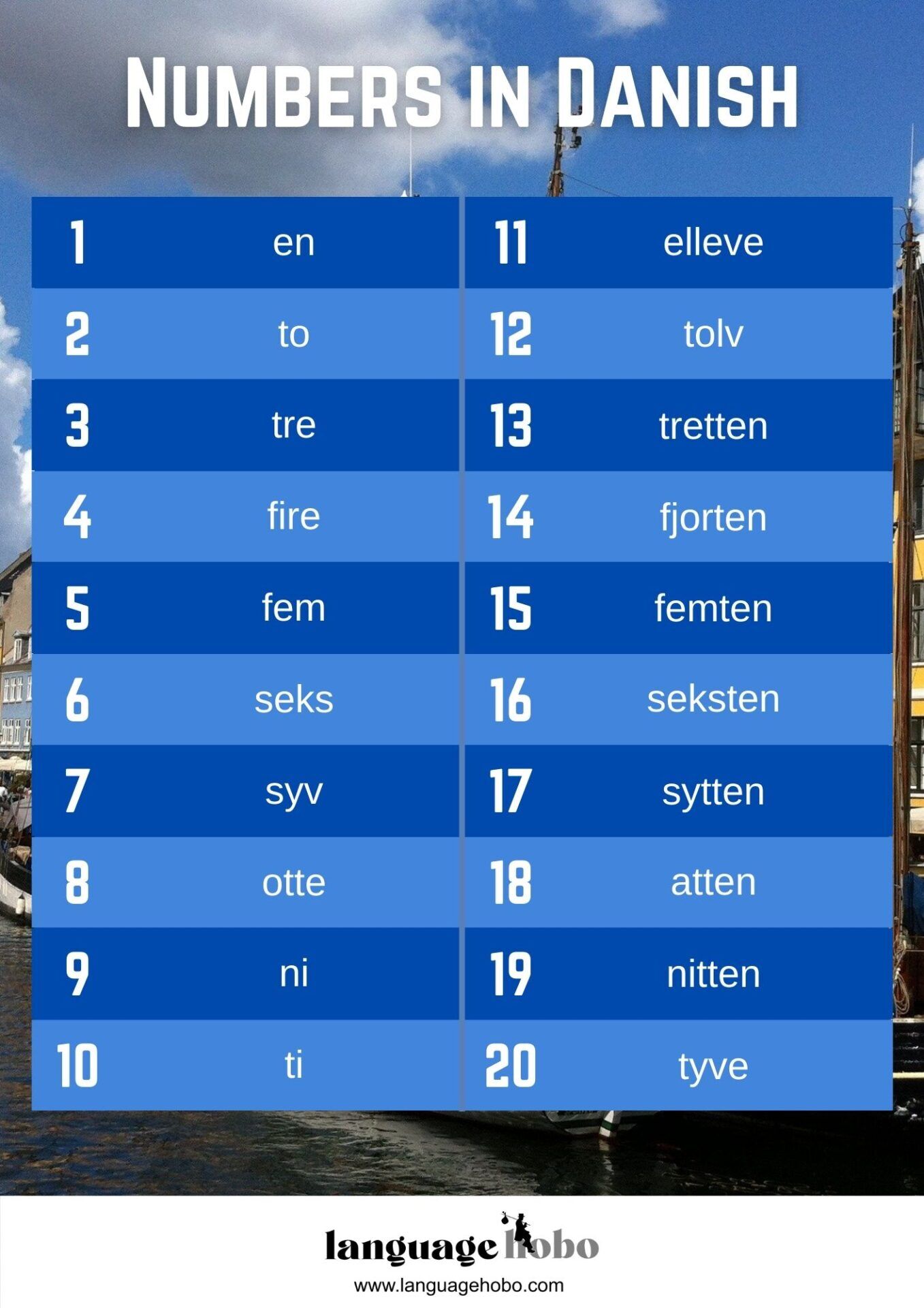Numbers And Counting In Danish
As a new learner of Danish, it’s essential to know how to count and understand Danish numbers. Numbers are a fundamental part of any language, and you’ll need to know them for many different situations, whether you’re buying groceries or telling time.
Now, we know that learning numbers can be daunting and a little dull, but they’re a necessary evil. It’s best to get them out of the way early on so that you can focus on other, more interesting aspects of the language. That’s where Language Hobo comes in!
We’ve created this guide to introduce you to the different types of Danish numbers you’ll encounter as you progress in the language. Everything has been arranged into categories, so you can find the specific information you need quickly and easily.
Cardinal numbers in Danish

Cardinal numbers are used to express quantity. In other words, they tell you how many of something there are. These are numbers in their regular form and the ones you’ll encounter most.
Numbers 1-20 in Danish are pretty straightforward, especially for English speakers. You’ll see shortly that many of them sound almost identical to their English counterparts (e.g. ‘eleven’ = “elleve”).
Teens in Danish
The ‘teens in Danish (thirteen, fourteen, etc.), again, look very similar to what you’re used to in English, though they’re all relatively irregular. The Danish word “-ten” is suffixed to units 3-9, some of which are slightly altered to make them easier to pronounce. For example:
- fourteen isn’t “fire” + “-ten”, it’s “fjorten”
- seventeen isn’t “syv” + “-ten”, it’s “sytten”
Tens in Danish
The tens in Danish are a little less straightforward, and you’ll notice that there are quite a few irregularities (as though the Danes couldn’t decide on a system and just made it up as they went along!).
The first thing to note is that Danish counting from 21 onwards follows a Germanic system that you’ll also find in German (and old English). That is, units come before tens. So, numbers 21-29 are literally ‘one-and-twenty’, ‘two-and-twenty’, and so on. In Danish, this would be: “enogtyve”, “toogtyve”.
This applies to all tens with units.
The second thing to note is that, for the most part, the tens on their own don’t seem to follow any real pattern, so you’ll just have to learn them as individual words. Check out the table below to see them in action.
| Cardinal Numbers (English) | Kardinaltal (Danish) |
|---|---|
| zero | nul |
| one | en |
| two | to |
| three | tre |
| four | fire |
| five | fem |
| six | seks |
| seven | syv |
| eight | otte |
| nine | ni |
| ten | ti |
| eleven | elleve |
| twelve | tolv |
| thirteen | tretten |
| fourteen | fjorten |
| fifteen | femten |
| sixteen | seksten |
| seventeen | sytten |
| eighteen | atten |
| nineteen | nitten |
| twenty | tyve |
| twenty-one | enogtyve |
| twenty-two | toogtyve |
| thirty | tredive |
| thirty-one | enogtredive |
| thirty-two | toogtredive |
| forty | fyrre |
| fifty | halvtreds |
| sixty | tres |
| seventy | halvfjerds |
| eighty | firs |
| ninety | halvfems |
| hundred | (et) hundrede |
| one hundred and one | (et) hundrede og en |
| one hundred and twenty-five | hundrede og femogtyve |
| two hundred | to hundrede |
| three hundred | tre hundrede |
| four hundred | fire hundrede |
| five hundred | fem hundrede |
| six hundred | seks hundrede |
| seven hundred | syv hundrede |
| eight hundred | otte hundrede |
| nine hundred | ni hundrede |
| thousand | (et) tusind |
| million | (en) million |
Ordinal numbers in Danish
Ordinal numbers are what we use to discuss order or rank. That is, they tell us the position of something in a sequence. For example, “first”, “second”, “third” etc.
In Danish, ordinal numbers end with the suffix “-de” or “-te” attached to the relevant cardinal number (or a form of it). Notable exceptions are “anden” (second) and “tredje” (third), which have irregular endings.
If the cardinal number ends in “-ve” or “-m”, the ordinal will end in “-te”; the rest will generally end in “-de”.
Some Danish ordinal numbers also have irregular beginnings – that is, the cardinal half of the number changes in some way. For example, “første” (first), “fjerde” (fourth), and “sjette” (sixth) are all irregular.
Take a look at the table below to see how they all work.
| Ordinal Numbers (English) | Ordenstal / Ordinaltal (Danish) |
|---|---|
| first | første |
| second | anden |
| third | tredje |
| fourth | fjerde |
| fifth | femte |
| sixth | sjette |
| seventh | syvende |
| eighth | ottende |
| ninth | niende |
| tenth | tiende |
| eleventh | ellevte |
| twelth | tolvte |
| thirteenth | trettende |
| fourteenth | fjortende |
| fifteenth | femtende |
| sixteenth | sekstende |
| seventeenth | syttende |
| eighteenth | attende |
| nineteenth | nittende |
| twentieth | tyvende |
| thirtieth | tredivte |
| thirtieth-third | treogtredivte |
| fortieth | seksogfyrretyvende |
Fractions in Danish
Fractions are numbers that express a part of a whole, such as ‘half’ and ‘a quarter’. These are pretty important things to learn, as you’ll encounter them fairly often, especially when talking about time and weight.
The table below introduces the main fractions you need to know in Danish.
| Fractions (English) | Brøker (Danish) |
|---|---|
| half | en halv |
| a quarter | en fjerdedel/kvart |
| a third | en tredjedel |
| two thirds | to tredjedele |
| three fifths | tre femtedele |
| three quarters | tre fjerdedele |
Other
This section deals with other sorts of numbers that don’t neatly fit into a box. They’re things like tuples (double, triple) and multiplicative terms (once, twice).
You’ll use tuples to express quantity, while you’ll talk about frequency using multiplicative adjectives. Take a look.
| double | dobbel |
| triple | tredobbelt |
| dozen | dusin |
| once | en gang |
| twice | to gange |
| thrice | tre gange |
Equations in Danish
We thought it might be useful to include a few key mathematics terms related to equations, as you’ll eventually want to be able to add, subtract, etc. in Danish.
| Maths (English) | Matematik (Danish) |
|---|---|
| plus | plus |
| minus | minus |
| divided by (÷) | divideret med |
| times | ganget med |
| equals/is | er |
Age in Danish
A common question you might hear is ‘How old are you?’. Should you decide not to tell the person to mind their own business, it might be worth learning how to both recognize the question and answer it.
| How old are you? | Hvor gammel er du? |
|---|---|
| I am twenty-five years old | Jeg er femogtyve |
| I am twelve years old | Jeg er tolv |
Time in Danish
At some point, while you’re out and about in Denmark, you’ll either want to know the time or tell someone the time if they ask.
Luckily, telling the time in Danish is simple, and you shouldn’t have too many problems with it. To respond when someone asks, ‘What’s the time?”, you’d simply say “Klokken er…” and give them the hour using cardinal numbers 1-12. That’s pretty much it!
(We go into more detail about how to use fractions while telling the time in our article Days of the Week, Months of the Year, Seasons, Weather, and Time in Danish.)
| What’s the time? | Hvad er klokken? |
|---|---|
| It’s seven o’clock | Klokken er syv |
| It’s four o’clock | Klokken er fire |
There’s a lot to take in here, but don’t worry if you don’t get it all immediately. Just focus on the things you think will be most useful to you and come back to the rest later.
We do believe you should try to familiarize yourself with the way Danish numbers work as early as you can, though, especially if you plan on spending any length of time in Denmark.
The good news is that, for an English speaker, Danish numbers should pose very few problems; and with a little practice, you’ll have them down pat in no time!
If you want to learn some more Danish, check out our post Danish Poems and Rhymes for Children, or if you’re planning a trip to Denmark, have a look at our list of the Best Danish Phrasebooks for Learners and Travelers.




